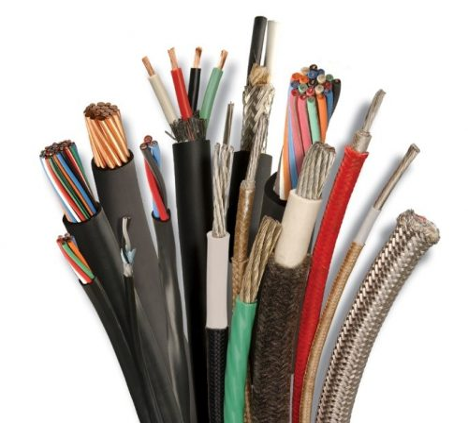Electric energy has become one of the most useful and widely used energy due to its ease of transmission. Transmission of electrical energy over long distances leads to the loss of a large part of this energy. Therefore, to reduce this waste, wires and cables are used. In this case, it is possible to distribute electrical energy all over the world in the best possible way with minimal waste. Cables and wires have various structures based on the amount of current transfer, which is discussed in this article.
High voltage cable wire raw materials
High voltage cable, like other cables, is responsible for transmitting electric current. What distinguishes the performance of such cables is their ability to transmit high voltage currents. Therefore, it can be said that the high voltage cable has a very high power in transmitting electric current, that is why they are used in certain places.
A steel core is used in the structure of the high voltage cable. This core is covered by an aluminum coating. The use of its aluminum core and media has led to an increase in the malleability and flexibility of the cable. For this reason, it shows a very high resistance against pressure and impact.
The insulation used in the high pressure cable is made of XLPE or PVC and in the form of wire or semi-expanded. In order to make the field around the core uniform around the conductor part of the wire, a semiconductor layer has been used. The type of insulation applied to the cable determines the final thickness of the cable. The most important part of high voltage cables is the shield layer, which is responsible for protecting the cables. All cables have a part called sheath in their structure. The sheath protects the cable from mechanical damage. It should be noted that sometimes graphite paper is also used in the structure of high voltage cables. The outermost part of the cable, which has a protective role, is made of PV material and is colored red or black.

Raw materials of medium pressure cable wire
Medium pressure cables are able to transmit electric current with a pressure of 6 to 30 volts. These cables are mainly made of copper or aluminum and are produced in the form of single or three strands. Medium voltage cable is widely used and is used to supply electricity to commercial or residential buildings, distribution circuits, switchboards, power plants, etc. The structure and raw materials used in this wire model are as follows:
- Regular and multi-component twisted conductors are used in the medium pressure cable structure. The material of the conductor is mainly annealed copper or aluminum.
- Conductor screen is another part of this cable that is placed on the conductor part as an extruded semi-conductor compound. The task of this section is to reduce the intensity of the electric field between the XLPE and the conductor.
The insulating part of this cable is made of XLPE with appropriate thickness in order to meet the electrical and physical requirements. This part must have high resistance to heat and humidity. - The insulating screen is another part of the cable that has the same function as the conductor screen. The insulating screen is placed on the insulating part and creates an extruded semiconductor compound on the insulation.
At high voltages, the metal shield is responsible for neutralizing the electric field outside the cable. In general, the shield is responsible for returning the capacitor charge current, directing the earth fault current until the system shuts down, and reducing the electrical impact in the environment around the cable.Filler is used to keep the elements inside the cable. In making cables, this part can be ignored, but it is better to use it. - The bottom layer puts the previous layers together and makes the conditions favorable for placing the next layer, the armor. Basically, the material of the lower part is thermoplastic or thermosetting.
- Armor is responsible for protecting the cable against physical pressure and is woven in the form of steel wire.
- To protect the cable from external factors such as moisture, corrosive substances, etc., an outer sheath is used.

Raw materials of low pressure cable wire
The low voltage cable is designed for voltage levels between 500 and 1000 volts. In its structure, different covers and variable conductors are used, so based on the type of insulating material and the number of strands, they can be divided into 2 or 5 strands cables. Basically, weak pressure cable is used in building electricity.
The conductor used in the low voltage cable is made of copper (99.5% purity) and aluminum. This conductor may be used in the form of spreading, semi-circular spreading, fixed installation, monolayer, semi-spreading sector, etc.; But basically, in order to increase the durability and longevity of these cables, uniform strands are used.
An insulating coating is placed on the conductor section, the thickness of which changes according to the voltage level. Basically, the insulating cover is made of PVC and XLPE. Finally, filler is used to fill the empty space in weak pressure cables. The filler gives the cable the ability to bend up to about 15 times the diameter of the cable.

Wire raw materials
The electric wire is also made up of two parts, the conductor and the cover, the conductor part is responsible for the transmission of electricity and the cover is responsible for preventing the leakage of electricity. Copper and aluminum are mainly used in the conductor section. Copper shows great resistance against atmospheric changes. Also, its malleability is very high. It should be noted that the copper used in the wire must have a purity greater than 99.5%.
In addition to copper, aluminum metal is also used in the conductor section of the wire. This metal is cheaper than copper and its resistance to weather changes and oxidation is lower. The combination of copper and aluminum in electric wires is such that copper strands are wrapped around aluminum strands. In addition to saving costs, this also compensates for the low resistance of aluminum against atmospheric changes.
The insulation and covering of the wires is made of PVC. This part has a protective role and prevents electricity leakage. PVC is an electrical insulator that has a better performance than oil insulators. In addition, its resistance is higher and its price is lower. Another feature of PVC is its high flexibility. This has led to an increase in the flexibility of electrical wires and cables. The long life of PVC has made the resulting wires suitable for construction purposes because the probability of their damage is very low.
In addition to the items mentioned in the structure of the wires, materials such as cross-linked polyethylene, XLPE, galvanized wire, PP tape, wooden and iron spools, waterproof tape, pigment (to color colorless materials) and… are also used as coating materials. will be

final word
In this article, it was pointed out the division of wires and cables based on the amount of voltage they can withstand. All the items mentioned above have more detailed divisions and more diverse types. Depending on the type of use of wire and cable, changes are made in the type of raw materials and their production methods. Therefore, it can be said that the mentioned items refer to the general structure of wires and cables.
